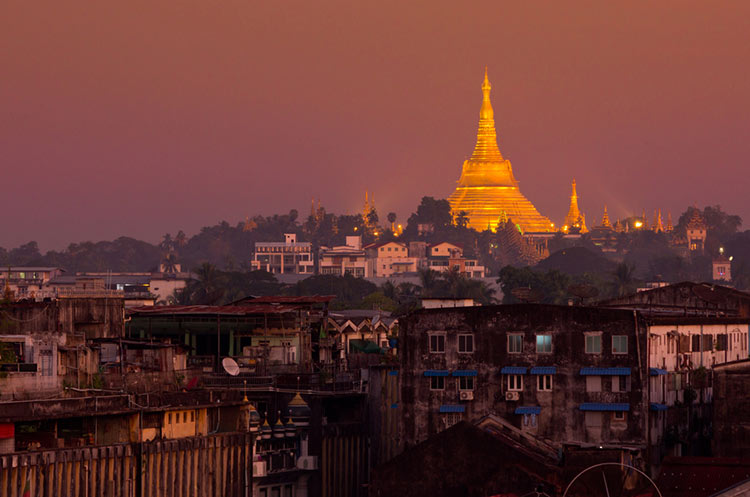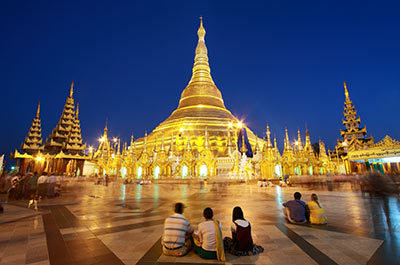
Burma
Largely undiscovered country with many magnificent sites
Burma, also known as Myanmar is one of the larger countries of South East Asia and also one of the poorest. It borders Thailand, Laos, China, Bangladesh and India and has a very long coastline on the Andaman Sea and the Bay of Bengal.
The country’s largest city is Yangon (formerly named Rangoon), which is the entry point to Burma for most foreign tourists. It was until very recently the capital city, until the newly built city Naypyidaw was made the new capital of Myanmar.
Burma is a country large undiscovered by foreign tourists mainly due to the isolation the country has been in for decades and the restrictions that were imposed on foreigners.
A step back in time
A visit to Burma is a step back in time in many ways. It is a country where men still wear traditional clothes like the longyi, horse carts serve as taxi in rural areas and until very recently ATM’s were an unknown thing.
Burma is a mostly Buddhist country, the temple and ancient traditions still play an important role in society, especially in rural areas. It is also a country where superstition and ancient spirit worshipping are a common thing. Mount Popa, not far from Bagan, is the home of the 37 most highly venerated Nat spirits.
Since the country has moved more towards democracy, the number of foreign tourists visiting Myanmar is growing. Tourism infrastructure however is not at the same level as neighboring Thailand and during high season it can be hard to find accommodation. In the more remote areas roads can be in a poor state of repair and travel can be slow and uncomfortable.
In spite of this, Burma is a country worth a visit with a great number of magnificent sites like the ancient city of Bagan, Buddhist temples like the immaculate Shwedagon Paya in Yangon and sites of scenic beauty like Inle Lake.
Recent history
The country was a British colony from 1824 until 1948. Many colonial era buildings can still be seen in cities like Yangon. During the second World War Japan occupied Burma. The infamous Death Railway was built between Thailand and Burma to supply the Japanese troops. In 1962 military rule was established, which officially ended in 2011. Since the 2010 elections a number of reforms have been implemented towards more democracy. Relations with other countries have improved, while some of the sanctions that were imposed have been lifted.
Sites to see in Myanmar
Burma is a country with a long and very rich history and an array of amazing sites. The country was the scene of several ancient civilizations and some of the most powerful empires of its days, like the Bagan Kingdom and the Taungoo dynasty which at the peak of its power around 1580 included not only present day Myanmar, but also Thailand and parts of China and Laos.
Historical sites
One of the most impressive and largest ancient sites in Asia is Bagan located in the dry zone of Central Burma. During the 11th and 13th century well over 10,000 Buddhist monuments were built in the plains of Bagan, of which some 2,200 remain today. It is a magnificent site dotted with pagodas and temples in various styles, some of which have well preserved frescoes and mural paintings.
Temples and Pagodas
During its long history with Buddhism a great number of temples and pagodas were built across the country. The most famous one is the Shwedagon Paya in Yangon, an important pilgrimage site for Burmese Buddhists.
Among the many others worth a visit are the 65 meters long Reclining Buddha of the Chauk Htat Gyi Pagoda and the Sule Pagoda in Yangon and the Mahamuni Pagoda in Mandalay.
Mandalay and the surrounding ancient cities of Mingun, Amarapura, Sagaing and Innwa are known as the Buddhist center of Burma. Hundreds of Buddhist monasteries and pagodas dot the hills of Sagaing. The Mingun Paya, that was meant to be the largest pagoda ever built is perhaps the most impressive on the banks of the Irrawaddy river.
Other sites to see
Another famous attraction is the Inle Lake, a large natural lake in mountainous Central Burma, known for its leg rowing fishermen and floating gardens. The nearby Pindaya cave in the hills of Pindaya village is filled from top to bottom with Buddha images from several eras, in various styles and sizes.
The all teak wood Mandalay Royal Palace was the last Palace built by Burmese Royals. After the Palace was destroyed by fire, it has been rebuild following the original concept.
Another magnificent site is the Kyaikhtiyo Pagoda or Golden Rock in the Yangon area. A large golden glowing boulder which looks like it can fall down in the valley beneath it at any moment has a pagoda on top of it enshrining a hair relic of the Buddha, which makes this an important Buddhist pilgrimage site. Although it takes quite a bit of effort to get there, the site is well worth a visit.
Beaches & islands
Burma’s coastline measuring thousands of kilometers consists of largely undiscovered tropical beaches on the Andaman Sea and the Bay of Bengal. One of the country’s developing beach resorts is Ngapali, an idyllic charming place near the town of Thandwe.
Burma climate
Burma has a tropical monsoon climate, with high humidity, high temperatures and lots of rainfall, especially in the coastal areas. The dry zone in Central Burma including Bagan is the noticeable exception; it receives very little rain and looks like a desert in some areas.







